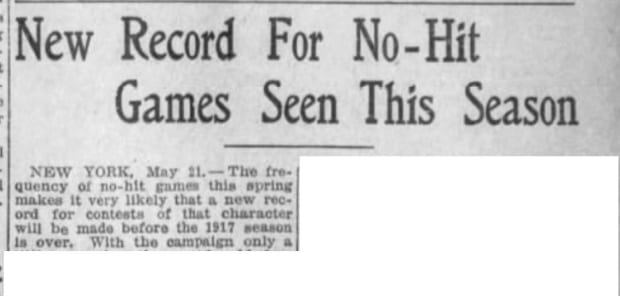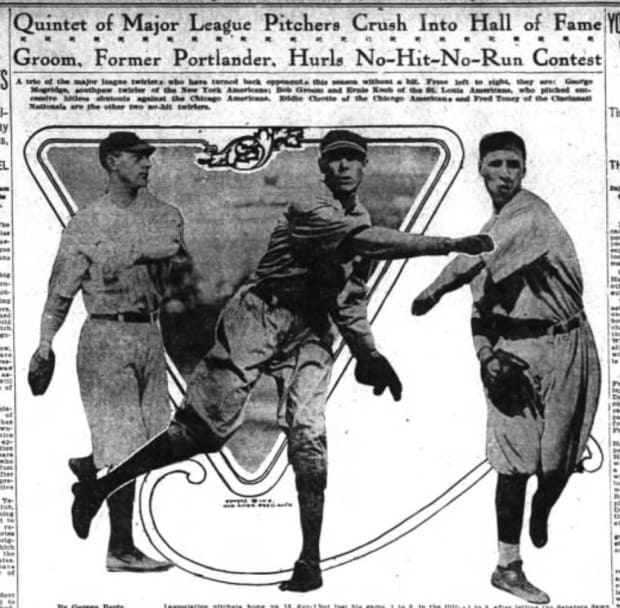The six no-hitters thrown just weeks into the 2021 season mirrors those of the 1917 season, when five were tossed in the span of 23 days.
Welcome to The Opener, where every weekday morning you’ll get a fresh, topical column to start your day from one of SI.com’s MLB writers.
“The frequency of no-hit games this spring makes it very likely that a new record for contests of that character will be made before the… season is over.”
That’s a bold statement for May 21. But it’s also hard to argue with—after the first few weeks of the season featured a cluster of no-hitters, including two on back-to-back nights, could anyone be blamed for guessing that baseball might be on track to set a record?
This was the first line of a story that ran in the Los Angeles Evening Express on May 21, 1917. But there will quite likely be a similar one somewhere before the end of day on May 21, 2021. Because for all the discussion about how unusual the current situation is? Baseball has been here before. Kind of.
MLB has seen six no-hitters in the last 42 days. It’s somewhat akin to what happened in the spring of 1917, when there were five in 23 days, with a sixth added a little more than a month later. (The sixth one, on June 23, was the last of the season—which meant that the league ended up simply tying the existing record for a season with the most no-hitters, set in 1908, rather than establishing a new one.) But that surge generated much of the same public discourse that baseball is experiencing right now: Were no-hitters still exciting? How many would be too many? The answers will probably sound familiar.

“It has been remarked lately that no-hit games are becoming so common that they are no longer remarkable feats,” went that May 21 story from the Los Angeles Evening Express. But this didn’t mean that there was no excitement to be found in them: “The fact that [George] Mogridge was the first Yankee pitcher in the history of the New York American League club to pitch a hitless game indicates that hitless games really are rare and remarkable pitching feats.” Sound like anything you might have heard recently about, say, the first Padre pitcher in the history of the San Diego National League club to pitch a hitless game?
But it was easy for people to be thrilled for George Mogridge’s no-hitter in April. By the time that baseball had moved on to St. Louis Browns pitcher Ernie Koob’s no-hitter in May—the fourth of the season and the second in a week—the tone had started to sour a bit. Here’s the first line from the game story in the St. Louis Post-Dispatch: “Ernie Koob of Kalamazoo yesterday tantalized and teased the White Sox on the local American League terrain until they yielded unto him a no-hit game, which really isn’t anything devilish in these dark, dank, dismal days of sunless Spring.”
And that was the take from the hometown paper! Although the story found its way to a peppier tone eventually (“Koob of Kalamazoo, our hats are off to you!”), it first made sure to note that he actually hadn’t pitched that well: “Like most no-hit games, Koob’s was hardly immaculate.” (He walked five batters.)
There were some who still managed to find joy in every no-hitter: The Oregon Sunday Journal in Portland ran this spread to celebrate the fifth one of the season, from Bob Groom, suggesting that a no-no was a hall-of-fame feat. (The honor would have been hypothetical at the time—the National Baseball Hall of Fame in Cooperstown wouldn’t open until 1939.)

Elsewhere, there were writers searching for patterns in the heap of no-hitters. Like the fact that the same teams kept showing up over and over. (Sound familiar?) “By a freak coincidence all five no-hit games in the American League concerned either the present world’s champion White Sox or the former world’s champion Red Sox,” wrote the Baltimore Sun. And there was speculation about just what could be causing so many—while the modern version of that conversation focuses on the drop in batting average and rise in strikeouts, in 1917, one of the theories was that hitters were getting exhausted from too many doubleheaders. “Not in the history of the American League have doubleheaders piled up on the clubs as this year,” a sportswriter noted in the St. Joseph News-Press in July 1917. “That is one of the reasons why the pitcher, and not the batter, is to be the determining factor in this year’s pennant battle.”
This is not to suggest that 2021 is exactly like 1917; the current spate of no-hitters comes amid a moment of reckoning for the offensive structure of the game as a whole while the one more than 100 years ago came across more as a random burst. (As the Los Angeles Evening Express put it at the time: “No-hit games have a curious way of running in clusters.”) But whether you’re starting to believe that a no-hitter “really isn’t anything devilish” or is worthy of the Hall of Fame—you’re not alone. And you never were.
More MLB Coverage:
• Corey Kluber Reclaims His Ace Status
• What's Behind Baseball's Hit-by-Pitch Epidemic?
• Want to Fix the Unwritten-Rules Mess? Let Teams Give Up
• MLB Must Act Before Beanballs Hurt Players and the Game